Home Nebulizer Therapy
What is a nebulizer?
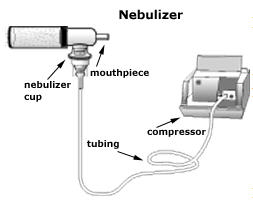 A nebulizer changes liquid medicine into fine droplets (in aerosol or mist form) that are inhaled through a mouthpiece or mask. Nebulizers can be used to deliver bronchodilator (airway-opening) medicines such as albuterol (Ventolin, Proventil or Airet) or ipratropium bromide (Atrovent).
A nebulizer changes liquid medicine into fine droplets (in aerosol or mist form) that are inhaled through a mouthpiece or mask. Nebulizers can be used to deliver bronchodilator (airway-opening) medicines such as albuterol (Ventolin, Proventil or Airet) or ipratropium bromide (Atrovent).
A nebulizer may be used instead of a metered dose inhaler (MDI). It is powered by a compressed air machine and plugs into an electrical outlet. Portable nebulizers, powered by an internal battery or cigarette lighter, are available for individuals requiring treatments away from home.
Nebulizer care guidelines
Your home care company will show you how to use the nebulizer. You will need the following supplies to give the nebulizer treatment:
- Air compressor
- Nebulizer cup
- Mask or mouthpiece
- Clean eye droppers or other measuring devices to dispense the medication
Treatment procedure
1. Place the air compressor on a sturdy surface that will support its weight. Plug the cord from the compressor into a properly grounded (three prong) electrical outlet.
2. Wash your hands with soap and warm water, and dry completely with a clean towel.
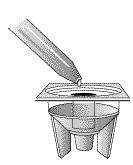 3. Carefully measure the medicine exactly as you have been instructed. Use a separate, clean measuring device (eyedropper or syringe) for each medicine.
3. Carefully measure the medicine exactly as you have been instructed. Use a separate, clean measuring device (eyedropper or syringe) for each medicine. 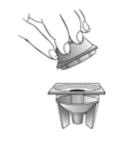
4. Remove the top part of the nebulizer cup, as shown to the left.
5. Place your medicine in the bottom of the nebulizer cup, as shown to the right.
6. Attach the top portion of the nebulizer cup and connect the mouthpiece or face mask to the cup.
7. Connect the tubing to both the aerosol compressor and nebulizer cup.
 8. Turn on the compressor with the on/off switch. Once you turn on the compressor, you should see a light mist coming from the back of the tube opposite the mouthpiece as shown to the left.
8. Turn on the compressor with the on/off switch. Once you turn on the compressor, you should see a light mist coming from the back of the tube opposite the mouthpiece as shown to the left.
9. Sit up straight on a comfortable chair.
10. If you are using a mask, position it comfortably and securely on your face as shown to the right.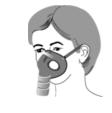
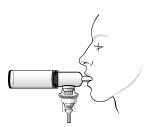 11. If you are using a mouth piece, place it between your teeth and seal your lips around it as shown to the left..
11. If you are using a mouth piece, place it between your teeth and seal your lips around it as shown to the left..
12. Take slow, deep breaths through your mouth. If possible, hold each breath for two to three seconds before breathing out. This allows the medication to settle into the airways.
13. Continue the treatment until the medication is gone (about seven to 10 minutes).
14. If you become dizzy or feel “jittery,” stop the treatment and rest for about five minutes. Then continue the treatment, but try to breathe more slowly. If these symptoms continue with future treatments, inform your health care provider.
15. Turn the compressor off.
16. Take several deep breaths and cough. Continue coughing and try to clear any secretions you might have in your lungs. Cough the secretions into a tissue and dispose of it properly.
17. Wash your hands with warm water and soap, and dry them with a clean towel.
Care of nebulizer
Cleaning and disinfecting your equipment is simple, yet very important. Cleaning should be done in a dust- and smoke-free area away from open windows. Here is how to clean your equipment:
1. After each treatment, rinse the nebulizer cup with warm water, shake off excess water and let it air dry.
2. At the end of each day, the nebulizer cup, mask, or mouthpiece should be washed in warm, soapy water using a mild detergent, rinsed thoroughly, and allowed to air dry.
Note: There is no need to clean the tubing that connects the nebulizer to the air compressor.
Do not put these parts in the dishwasher.
3. Every third day, after washing your equipment, disinfect the equipment using a vinegar/water solution or the disinfectant solution your supplier suggests.
To use the vinegar solution, mix 1/2 cup white vinegar with 1-1/2 cups of water. Soak the equipment for 30 minutes and rinse well under a steady stream of water. Shake off the excess water and allow to air dry on a paper towel. Always allow the equipment to completely dry before storing in a plastic, zipper storage bag.
Compressor care
- Cover the compressor with a clean cloth when not in use. Keep it clean by wiping it with a clean, damp cloth as needed.
- Do not put the air compressor on the floor either for treatments or for storage.
- Check the air compressor’s filter as directed. Replace or clean according to the directions from your equipment supplier.
- Always have an extra nebulizer cup and mask or mouthpiece in case you need it.
- Store your medicines in a cool, dry place. Check them often. If they have changed color or formed crystals, throw them away and replace them with new ones.
- All equipment for your nebulizer therapy can be obtained through your equipment supplier.
Important: Unplug the compressor before cleaning it.
